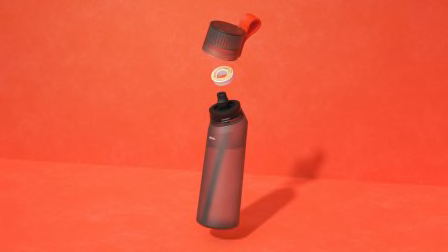The Truth About What’s Really in Prime Energy Drinks
Here’s what to know about how it and other energy drinks might affect the health of kids, teens, and adults

Since 1997, when Red Bull debuted on the U.S. market, energy drinks have been a popular way to quench thirst, as well as an ongoing topic of controversy. Several brands have come under scrutiny for their ingredients, especially their caffeine levels, and their appeal to teens and tweens.
The latest energy drink to be put in the hot seat is Prime Energy. Launched in 2022 by social media influencers Logan Paul and Olajide William Olatunji, who goes by KSI, the brand has been wildly successful, especially among kids. The company markets the product as a healthier alternative to other sports and energy drinks.
Prime’s popularity recently caught the attention of Sen. Chuck Schumer (D-N.Y.), who has sent a letter to the Food and Drug Administration asking it to investigate the caffeine content and the marketing practices of Prime Energy drinks, claiming that the brand is heavily marketed to people under 18.
What’s an Energy Drink Anyway?
There’s no standard definition. Some are more like sports drinks with electrolytes (sodium and potassium), meant to replenish your body after exercise. Others contain vitamins, amino acids (the building blocks of protein), and ingredients like taurine, ginseng, and caffeine. Many contain high levels of sugars, while others have artificial sweeteners, so they’re lower in calories. For example, Prime Energy has 10 calories in a 12-ounce can and Prime Hydration has 25 calories in a 16.9-ounce bottle. Both products are sweetened with the artificial sweetener sucralose.
An “energy” drink that’s very low in calories doesn’t quite make sense, says Amy Keating, RD, a CR nutritionist. “Calories, especially from carbohydrates, are what give your body energy,” she says. “Caffeine can make you feel more alert, but it won’t fuel your body.”
The Same Amount of Caffeine as in 2 Cups of Coffee Doesn’t Sound That Bad. What’s the Fuss About?
The FDA says that most adults can safely consume 400 mg of caffeine, but that doesn’t mean that’s a safe amount for kids. According to the American Academy of Pediatrics, 12- to 18-year-olds should have no more than 100 mg of caffeine a day, and those under 12 shouldn’t have any.
Caffeine can cause unwanted side effects, such as increased heart rate and body temperature, and nervousness. These effects are dose-dependent, which means kids might experience more side effects due to their smaller size, says Rebecca Carl, MD, chair of the American Academy of Pediatrics Council on Sports Medicine and Fitness. Studies in children and adults show that energy drinks may raise blood pressure and may cause changes in heart rhythm.
Energy drinks may trigger anxiety in kids with anxiety disorders as well. “We know there is a rise in mental health issues in kids and teens,” says Keating. “So there are physiological and mental health concerns.”
"Also, kids aren’t good at regulating themselves or making risk-benefit calculations about their current or future health,” says Carl. “If they have access to these drinks, they may drink more.”
There is a statement on the back of cans of Prime Energy, saying it’s not for people under age 18 or those sensitive to caffeine, but it’s in small type. That warning is also on the company’s website, but you have to go into the FAQs to find it.
A spokesperson for Prime said: “We started Prime last year with the launch of Hydration, a healthier sports drink alternative that comes in a bottle. Prime Energy, sold in a can, dropped in 2023 and contains a comparable amount of caffeine to other top-selling energy drinks. It complied with all FDA guidelines before hitting the market and states clearly on packaging, as well as in marketing materials, that it is an energy drink and is not made for anyone under the age of 18.”
The FDA is currently investigating the concerns outlined in Schumer’s letter, an agency spokesperson wrote in an email to CR. In the meantime, the FDA recommends carefully reviewing product labels before giving a product to children.
What About Energy Drinks Without Caffeine?
Depending on their ingredients, they may not be so good for you either. Some research suggests that potential adverse effects from energy drinks may not be due only to caffeine.
For example, in a small 2017 study published in the Journal of the American Heart Association, researchers tested an energy drink with sugar, caffeine, and an “energy blend" of B vitamins, amino acids, and herbal extracts against a drink with only caffeine and sugar in 18 people between the ages of 18 and 40.
They found that the study subjects had abnormal temporary changes in heart rhythm after consuming the drink with the energy blend, but not after consuming the caffeine drink. Both beverages caused elevations in blood pressure, but the increase lasted longer after drinking the energy blend. People complained of anxiety, stomach upset, trouble falling asleep, and other symptoms after drinking both beverages.
What’s also concerning is that scientists don’t know how many people experience adverse reactions like these from drinking energy drinks. “Many energy drinks used to be classified as dietary supplements, but now the majority are marketed as beverages,” says Chuck Bell, CR’s advocacy programs director. “If a supplement company receives a complaint of serious adverse effects, it’s required to report it to the FDA. Beverages don’t have to report adverse events. So we’re not able to fully track possible health problems consumers may be experiencing from these products.”
What Are the Ingredients in Prime Energy and Prime Hydration Drinks?
The base of both Prime drinks is filtered water and coconut water. They are sweetened with sucralose, and have electrolytes, B vitamins, and branch-chain amino acids. Only the energy drink has caffeine.
In addition to their caffeine, CR’s Keating has other concerns about the ingredients in these drinks.
For example, both drinks contain more than 100 percent of the recommended daily value of vitamins B6 and B12. While B vitamins do support energy production—they help your body turn the carbohydrates, fats, and protein in the foods you eat into energy—you don’t need mega doses to get that effect. And most people get enough B vitamins from food, says Carl at the American Academy of Pediatrics.
The daily values for nutrients are calculated for a 2,000-calorie diet, so some kids who eat less might need even less. While these vitamins may not pose immediate harm, combining these drinks with other fortified foods and vitamins can result in unnecessarily high intakes, Keating says.
Prime drinks contain sucralose, an artificial sweetener, rather than table sugar or high fructose corn syrup. But artificial sweeteners (sometimes called non-nutritive sweeteners, or NNS) may not be a safe alternative, especially for kids. Earlier this year, the World Health Organization advised against using artificial sweeteners for weight control. At the time, Francesco Branca, WHO director for nutrition and food safety, said in a statement: "NNS are not essential dietary factors and have no nutritional value. People should reduce the sweetness of the diet altogether, starting early in life, to improve their health."
Several studies have raised concerns about the effects of artificial sweeteners, and studies on these ingredients usually don’t include children. “We really don’t know if artificial sweeteners are safe, and if so, what’s a safe amount, especially for children,” says Carl.
As for amino acids, they’re thought to help with muscle recovery. But these building blocks of protein are amply supplied by protein-rich foods, such as meat, poultry, fish, beans, tofu, and nuts.
These Drinks Have Electrolytes. Isn’t That a Good Thing?
Electrolytes are minerals—calcium, sodium, magnesium, and potassium—that help balance the amount of water in the body. Prime Hydration contains moderate levels of the electrolytes magnesium and potassium, while Prime Energy has smaller amounts of these two minerals, plus a little calcium.
If someone is exercising for a long time, Keating says a sports drink that contains electrolytes may be useful, but that’s not usually the case for most adults or children. You can get plenty of electrolytes from fruits, vegetables, dairy, and other foods.
So What's the Best Thing to Drink While Exercising?
Water is best for both adults and kids. Kids especially don’t need any kind of energy or sports drink.
“Our main recommendation for most kids’ sports is to just drink water, especially if the game or practice is under 2 hours,” says Carl. The water will keep them hydrated, and electrolytes are generally plentiful in foods.
A sports drink may be appropriate for a child in a 6-hour soccer tournament, but even then, she says, water and snacks should do the trick. If you choose to give your child one of these beverages, Carl recommends paying close attention to the ingredients labels before buying a drink. “Some of these drinks have fine print that they aren’t for children, but they are marketed toward children with bright colors and images of people that children are watching,” she says. “Parents and coaches should make sure we’re protecting kids and looking into what’s in these drinks before buying them.”
@consumerreports Prime Energy contains more caffeine than what’s in a Starbucks Tall Dark Roast coffee, two 8-ounce cups of most other coffees, or two cans of Red Bull. Learn more through the link in our bio. #foodtok #primeenergy #primeenergydrink
♬ original sound - Consumer Reports



















